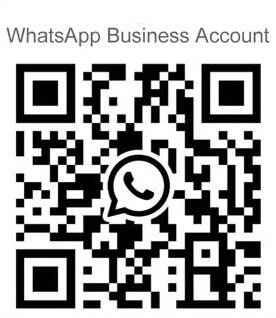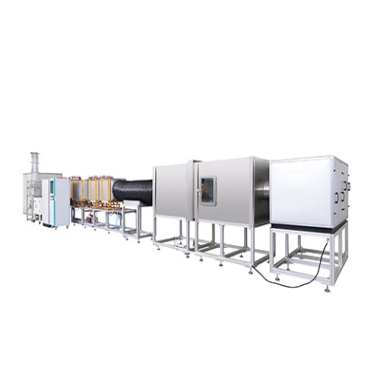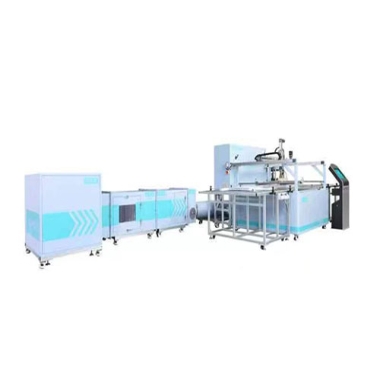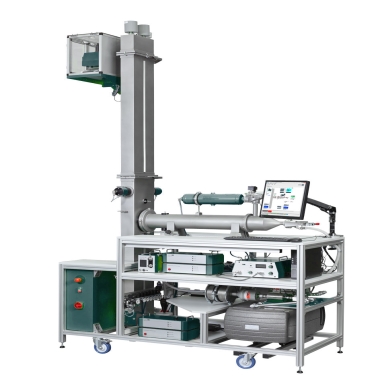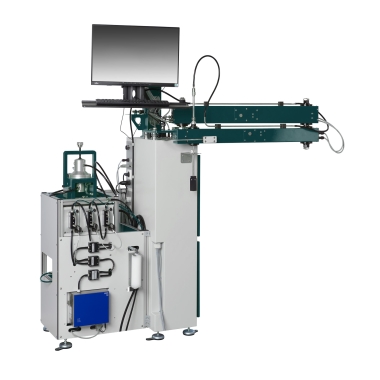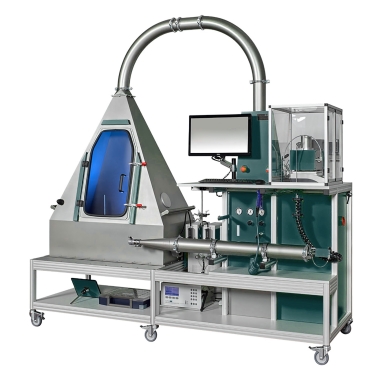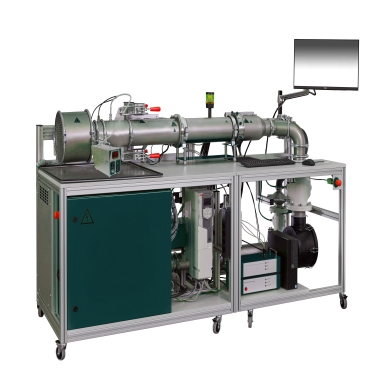Single Fiber Strength Tester

Introduction
In the tensile test, the measured fiber is sandwiched between the upper holder and the lower holder. According to the panel operation instruction, the monitoring and control program generates the step pulse by the pulse generator , moves up and down the holder by the stepping motor and the transmission mechanism, and reads the number of the step pulse from the reversible counter to complete the elongation measurement.
The load of the measured fiber is generated by the transmission mechanism on the load force sensor. The output signal is passed through the amplifier and the analog-to-digital converter, and the load measurement is completed by reading the conversion result from the monitoring and control program.
Application
The single fibers are stretched to break on a constant elongation extensometer (CRE) under specified conditions. The values of tensile strength, elongation at break, elongation strength, and initial modulus of the specimen obtained from the load-elongation curve or the data display acquisition system are suitable for the tensile test of chemical fiber and natural fiber Stretch performance test.
Standards
GB/T21120 Synthetic fibers for cement, cement mortar and concrete
GB/T14337 Testing method for tensile properties of man-made staple fibers
ISO 5079 Textiles - Fibres - Determination of breaking force and elongation at break of individual fibres
GB/T13835.5 Test method for rabbit hair—Part 5:Breaking tenacity and elongation at break of single fibre
ASTM D3822(M) Standard test method for tensile properties of single textile fibers
JIS L1015 Testing methods for man-made staple fibres
ASTM D1294/2524/3106/3217/1445 Method of test for breaking tenacity of wool fiber bundles
DIN53843-2 Testing of textiles– Loop tensile test for staple fibres
ISO3060 Textiles -- Cotton fibres -- Determination of breaking tenacity of flat bundles
BS5116、BS 4029 Hexagon socket screws and wrench keys: metric series —Part 5: Specification for hexagon socket set screws with cup point
Technical Parameters
Accessories
The device can indicate or record the load applied to the specimen and the corresponding elongation value; (Force sensor)
The device can make load-elongation curve; (Integrated software)
The gripper suitably holds a single fiber at the desired nominal gauge length; (Manual, pneumatic and electric. The pneumatic gripper avoids the influence of the measurement of the force sensor and also reduces the degree of damage to the special brittle material during the clamping process.)
The device has a different stretching speed; (Stepper motor)
The device is used to wet the fibers in a wet state experiment so that the fibers are immersed during the test without affecting the test results; (Containers)
The device is used to precisely calibrate the instrument.
In the tensile test, the measured fiber is sandwiched between the upper holder and the lower holder. According to the panel operation instruction, the monitoring and control program generates the step pulse by the pulse generator , moves up and down the holder by the stepping motor and the transmission mechanism, and reads the number of the step pulse from the reversible counter to complete the elongation measurement.
The load of the measured fiber is generated by the transmission mechanism on the load force sensor. The output signal is passed through the amplifier and the analog-to-digital converter, and the load measurement is completed by reading the conversion result from the monitoring and control program.
Application
The single fibers are stretched to break on a constant elongation extensometer (CRE) under specified conditions. The values of tensile strength, elongation at break, elongation strength, and initial modulus of the specimen obtained from the load-elongation curve or the data display acquisition system are suitable for the tensile test of chemical fiber and natural fiber Stretch performance test.
Standards
GB/T21120 Synthetic fibers for cement, cement mortar and concrete
GB/T14337 Testing method for tensile properties of man-made staple fibers
ISO 5079 Textiles - Fibres - Determination of breaking force and elongation at break of individual fibres
GB/T13835.5 Test method for rabbit hair—Part 5:Breaking tenacity and elongation at break of single fibre
ASTM D3822(M) Standard test method for tensile properties of single textile fibers
JIS L1015 Testing methods for man-made staple fibres
ASTM D1294/2524/3106/3217/1445 Method of test for breaking tenacity of wool fiber bundles
DIN53843-2 Testing of textiles– Loop tensile test for staple fibres
ISO3060 Textiles -- Cotton fibres -- Determination of breaking tenacity of flat bundles
BS5116、BS 4029 Hexagon socket screws and wrench keys: metric series —Part 5: Specification for hexagon socket set screws with cup point
Technical Parameters
| Items |
Standard requirements |
Design requirements |
Implementation methods |
| Load range |
According to the maximum load requirements of the specimen |
0-100cN | Outsourcing, pressure sensor |
| Load error | ±1% | ≤±1% | Sensor validity |
| Load resolution | 0.1cN | 0.1cN | Sensor accuracy |
| Elongation range | 100mm | 100mm |
Outsourcing, displacement sensor |
| Elongation error | 0.05,0.1mm | ≤0.01 | Sensor validity |
| Elongation resolution | 0.1% | 1% | Sensor accuracy |
| Clamp distance | 2-20mm | 1-20mm | Machining |
| Lower gripper descent speed | 5-20mm/min | 1-100mm/min | Outsourcing, stepper motor |
| Lower gripper stroke | 100mm | 100mm | Machining |
Accessories
The device can indicate or record the load applied to the specimen and the corresponding elongation value; (Force sensor)
The device can make load-elongation curve; (Integrated software)
The gripper suitably holds a single fiber at the desired nominal gauge length; (Manual, pneumatic and electric. The pneumatic gripper avoids the influence of the measurement of the force sensor and also reduces the degree of damage to the special brittle material during the clamping process.)
The device has a different stretching speed; (Stepper motor)
The device is used to wet the fibers in a wet state experiment so that the fibers are immersed during the test without affecting the test results; (Containers)
The device is used to precisely calibrate the instrument.
Note:QINSUN is very in place for textile testing and quality control,we have our own textile testing lab. Our textile testing equipment and testing methods are in the leading position in the industry. We have passed the textile testing certification and iso textile testing standards issued by a number of testing,We can provide textile testing equipment pdf manual. Sufficient inventory, big discounts, limited time promotion, Order now!
Leave Message Get Price


